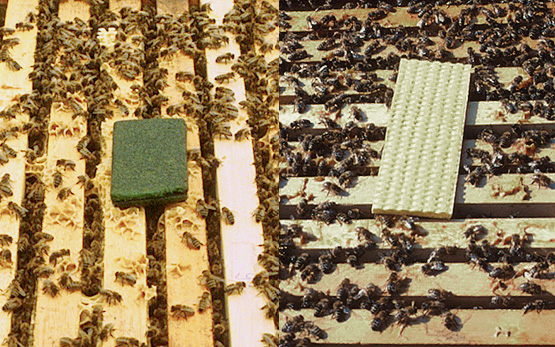Charrière J.-D., Würgler O.
Bienenhaltung in der Schweiz und im internationalen Vergleich.
Agroscope Transfer, 528, 2024, 1-31.
altre lingue: francese
Ebener A., Charrière J.-D.
Sostanze per l’uso apistico: Raccomandazioni del SSA e del CRA.
Ed. Agroscope e apiservice, Novembre, 2023, 1 p.
altre lingue: tedesco | francese
Ory F., Dietemann V., Guisolan A., Von Ah U., Fleuti C., Oberhaensli S., Charrière J.-D., Dainat B.
Paenibacillus melissococcoides sp. nov., isolated from a honey bee colony affected by European foulbrood disease.
International Journal of Systematic and Evolutionary Microbiology, 73, (4), 2023, 1-10.
Charrière J.-D., Dietemann V., Dainat B.
Guida sulla salute delle api: Redatto dal CENTRO DI RICERCA APISTICA.
Agroscope Transfer, 502, 2023, 1-45.
altre lingue: tedesco | francese
Ebener A., Charrière J.-D.
Sostanze per l’uso apistico: raccomandazioni del SSA e del CRA.
Ed. Agroscope e apiservice, 2023, 1 p.
altre lingue: tedesco | francese
Grossenbacher S., Charrière J.-D.
Winterverluste 2022/2023.
Schweizerische Bienen-Zeitung, 6, 2023, 38-41.
altre lingue: francese
Charrière J.-D.
Was sind die aktuellen Bedrohungen für die Honigbiene und wie versucht die Bienenforschung von Agroscope darauf zu reagieren?
In: Infoveranstaltung des BLW. 14. juin, Liebefeld - OFAG. 2023.
Ebener A., Charrière J.-D.
Sostanze per l’uso apistico: Raccomandazioni del SSA e del CRA.
Ed. Agroscope e Apiservice, maggio, 2023, 2 pp.
altre lingue: tedesco | francese
Gray A., Adjlane N., Arab A., Ballis A., Brusbardis V., Bugeja Douglas A., Cadahía L., Charrière J.-D., Chlebo R., Coffey M. F., Cornelissen B., Amaro da Costa C., Danneels E., Danihlík J., Dobrescu C. e altri
Honey bee colony loss rates in 37 countries using the COLOSS survey for winter 2019–2020: The combined effects of operation size, migration and queen replacement.
Journal of Apicultural Research, 62, (2), 2023, 204-210.
Grossar D., Haynes E., Budge G. E., Parejo M., Gaultier L., Charrière J.-D., Chapuisat M., Dietemann V.
Population genetic diversity and dynamics of the honey bee brood pathogen Melissococcus plutonius in a region with high prevalence.
Journal of Invertebrate Pathology, 196, 2023, 1-8.
Ebener A., Charrière J.-D.
Sostanze per l’uso apistico: Raccomandazioni del SSA e del CRA.
Ed. Agroscope e apiservice, Berna. dicembre, 2022, 1 p.
altre lingue: tedesco | francese
Ebener A., Charrière J.-D.
Sostanze per l’uso apistico: Raccomandazioni del SSA e del CRA.
Ed. Agroscope e apiservice, Berna. ottobre, 2022, 1 p.
altre lingue: tedesco | francese
Ory F., Duchemin V., Kilchenmann V., Charrière J.-D., Dainat B., Dietemann V.
Can trans-generational immune priming be used to protect honey bees against European foulbrood.
In: EurBee 9 – 9th European Congress of Apidology. 20-22 September, Ed. EurBee, Belgrade. 2022, 97.
Charrière J.-D., Schlagenhof L.
Control of wax moth by means of acetic acids.
In: 9th European Congress of Apidology. 20-22 September, Ed. Ljubiša Stanisavljević and Robert Paxton, Belgrade. 2022.
Reihl B., Charrière J.-D.
Eine starke Zunahme der Bienenvölkerverluste im Winter 2021/2022.
Schweizerische Bienen-Zeitung, 6, 2022, 30-33.
altre lingue: francese
Charrière J.-D., Dietemann V., Kast C., Droz B., Dainat B., Grossar D., Jeker L.
Was lief im Jahr 2021 am Zentrum für Bienenforschung?
Schweizerische Bienen-Zeitung, 8, 2022, 20-27.
altre lingue: francese
Brodschneider R., Schlagbauer J., Arakelyan I., Ballis A., Brus J., Brusbardis V., Cadahía L., Charrière J.-D., Chlebo R., Cheffey M., Cornelissen B., Amaro da Costa C., Danneels E., Danihlík J., Dobrescu C. e altri
Spatial clusters of Varroa destructor control strategies in Europe.
Journal of Pest Science, 2022, 1-25.
Charrière J.-D., Dietemann V., Kast C., Droz B., Dainat B., Grossar D., Jeker L.
Che cosa è successo al Centro di ricerca apistica nel 2021?
Agroscope Transfer, 447, 2022, 1-15.
altre lingue: tedesco | francese
Kast C., Kilchenmann V., Charrière J.-D.
A long-term survey on lipophilic acaricide residues in commercial Swiss beeswax.
In: AG-Tagung. 2022.
Ory F., Duchemin V., Kilchenmann V., Charrière J.-D., Dainat B., Dietemann V.
Lack of evidence for trans-generational immune priming against the honey bee pathogen Melissococcus plutonius.
PLOS ONE, 2022, 1-16.






